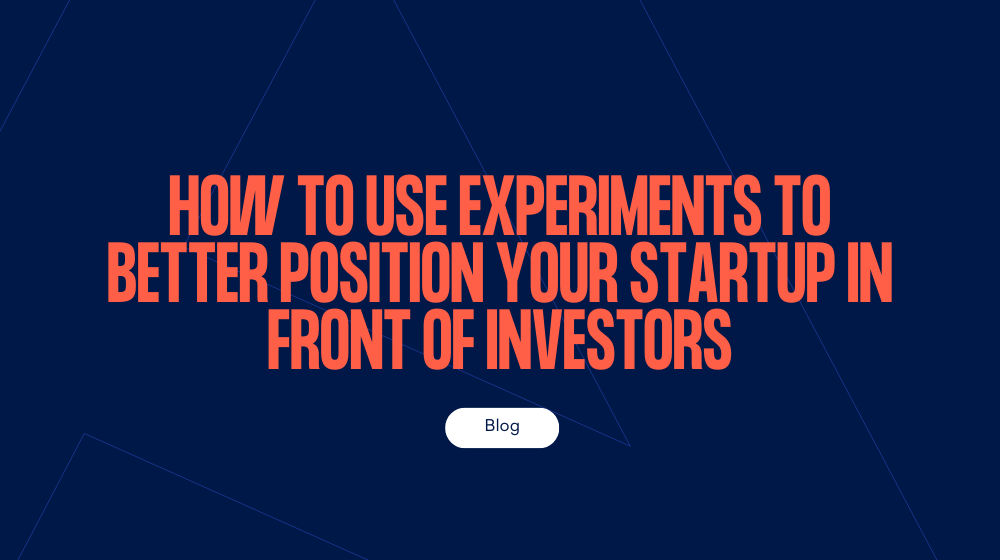When you’ve decided that securing private equity is a key part of your start-up or scale-ups growth, convincing investors of your product's value and its market potential couldn’t be more important. Many founders grapple with not only demonstrating their product's current success but also its scalability and profitability.
Adopting an experimental approach to their go-to-market strategy allow startups to gather convincing data that showcases their product’s market fit and growth potential. In this blog, we’ll have a quick delve into some different ways that founders can harness the power of growth experiments, specifically focusing on core investor metrics, to better showcase themselves to key investors.

Understanding core investor metrics
To effectively communicate with investors, it’s first vital to know and understand the metrics they care most about. The big hitters can be summarised below:
- Customer acquisition cost (CAC): This is the total cost your startup incurs to secure a new customer. It's super important to try to keep this number as low as possible while maximising the value each customer brings.
- Lifetime value to customer acquisition cost ratio (LTV:CAC): This key metric measures the return on investment from acquiring customers. A higher ratio means that your marketing and sales efforts are not only effective but also cost-efficient.
- Net new monthly recurring revenue (MRR) growth rate: This shows the monthly changes in revenue due to new customers, spotlighting your company's growth trajectory and potential scalability.
- Customer retention rate (CRR): This measures how well your company is able to retain its customers over time, which is a big indicator of general customer satisfaction and the overall quality of your product or service.
Leveraging experiments to optimise metrics
Now, let’s take a little look at how founders and their teams can design different types of growth experiments to gather benchmark against these metrics and enhance their attractiveness to investors:
Experiment example 1: Social engagement
Objective: To learn more about how potential customers interact with your brand or product.
Method: Utilise different advertising platforms such as Google Ads and various social media channels to identify the most cost-effective method for reaching potential customers. Then it’s time to roll out the A/B testing to refine your ad copy and targeting strategy, aiming to understand the cost per engagement for your target audience.
Investor appeal: This approach demonstrates your ability to expand market awareness and customer base efficiently at a scalable cost and will assure investors of your startup's growth potential as well as potential product market fit.

Experiment 2: Driving website traffic and conversions
Objective: To increase the conversion rate of website visitors into opportunities or paying customers.
Method: This step naturally comes after the previous experiment, where you’re confident that you can get people to engage with your brand.
Conduct A/B testing on various elements of your landing pages, including design, messaging, and calls to action. Analyse user navigation patterns on your website to identify and alleviate friction points that could be hindering conversion rates.
Investor appeal: Investors will be encouraged by efforts to optimise the sales funnel and improve your CAC rate and cost, indicating a proactive approach to growth. They’ll also appreciate your ability to optimise and tweak your strategy, based on what results you uncover along the way in terms of which messaging performs best.

Experiment 3: Boosting customer retention
Objective: To improve customer retention rates through enhanced onboarding processes and customer support.
Method: Modify and test different approaches to your onboarding process based on direct customer feedback - and then track changes in retention rates to measure the impact of these modifications, as well as noting which approaches worked best.
Investor Appeal: Demonstrating high retention rates can significantly enhance the perceived value of your startup, as it suggests a loyal customer base and a product that meets market needs.

Experiment 4: Streamlining the sales cycle
Objective: To reduce the duration and complexity of the sales process.
Method: Map the customer journey to pinpoint bottlenecks in the sales process. Experiment with two or three more simplified proposal formats and with quicker follow-up tactics to see which methods shorten the sales cycle without compromising customer satisfaction.
Investor appeal: A streamlined sales process suggests that your startup is agile and responsive, qualities that reduce CAC and improve overall efficiency.

Showcasing experiment results to investors
When presenting to investors, it's crucial to highlight how these experiments have positively influenced core metrics. A good starting point is to provide detailed examples of how your specific adjustments led to measurable improvements in performance. For instance, explain how refining ad spending not only expanded reach but also reduced CAC, or how modifications in the onboarding process led to higher customer retention rates.
By carefully enhancing these critical metrics through targeted growth experiments, we at Active Profile have witnessed startups drastically improve their operational performance and construct a persuasive, data-driven narrative that appeals to investors. This approach not only boosts a product’s current viability but also its potential for future success.
So, are you ready to explore how strategic experimentation can elevate your startup's appeal to investors? We hope so! Get in touch with the experiment experts at Active Profile and let us help you to take your scale and startup ambitions into an investor-ready reality.
For more information on our expert approach to growth experiments, download our Experiment Guide.



